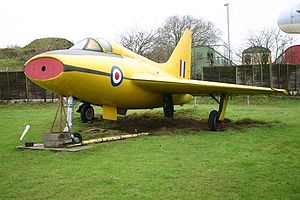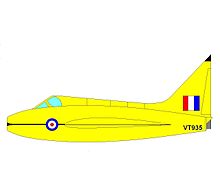Boulton Paul P.111 Video - Picture

|
|
Boulton Paul P.111

Aircraft Picture - VT 935, the P.111A on display at the Midland Air Museum
Role: research aircraft
Manufacturer: Boulton Paul
Designer: Dr S.C. Redshaw
First flight: 10 October 1950,
Retired: June 1958
Primary user: Royal Aircraft Establishment
Number built: 1
Variants: Boulton Paul P.120
The Boulton Paul P.111 (also called Boulton Paul BP.111) was a British experimental aircraft of the 1950s designed to explore the characteristics of tailless deltas.
Design and development
In the late 1940s and early 1950s the allied aircraft industries were engaged in many projects to confirm and develop the design ideas captured from the Germans at the end of the Second World War. As part of this activity the P.111 was built for the Air Ministry to specification E.27/46 by Boulton Paul Aircraft Ltd to investigate the possibilities of the delta planform wing.
The P.111 was designed as the smallest airframe which could couple an engine (Rolls-Royce Nene), an ejection seat (Martin Baker), and a delta wing. The latter was aerodynamically thin and had a sweep angle of 45°. Without tip extensions the wing was strongly cropped at about 75% of the full delta. The aircraft could be flown with these wings or with one of two pairs of extensions, the larger ones making an almost perfect pointed delta shape. These extensions allowed an investigation of the aerodynamic effects of the tip shapes of delta wings. Unlike its contemporary the Avro 707, roll and attitude were both controlled by a pair of elevons. The fin had an unswept trailing edge and its tip also could be removed and altered, though it seems it always flew with a very pointed tip. The P.111 was fitted with one of the first fully powered control systems, hydraulically driven with electrical trim tabs. Because the Nene had a centrifugal compressor, the P.111 had a rather tubby fuselage, with an oval nose intake. The inward-retracting undercarriage had a noticeably wide track and a tall nosewheel leg placed it at 17 on the ground The construction was all-metal with the exception of the wing extensions and the fin tip, which were of GRP.
Testing and evaluation
The P.111 made its first flight on 10 October 1950, at Royal Aircraft Establishment Boscombe Down with Squadron Leader Bob Smyth at the controls. Later test flying was carried out by the legendary test pilot, Alexander E. "Ben" Gunn, who described the aeroplane as "touchy" and "like flying a razor's edge". Part of the touchiness was because the power controls, essential at high speeds over 450 mph, lacked any feedback. There was also a large trim change when the undercarriage was raised or lowered and landing speeds were high in the absence of airbrakes and because of the need to keep the engine revs up to maintain the generators which powered the control surfaces. In the first few months of flying, the controls were spring loaded to give a semblance of feel and the rudder was altered to manual control. The P.111 initially had a one piece blown and continuously curved windscreen, but this was replaced by a more conventional framed screen with a flat forward pane.
After a landing accident in which the retractable landing gear failed to extend, the P.111 was modified during its repairs to improve the flight characteristics, and was re-designated the P.111A. Four "petal" airbrakes were added to the fuselage to lower landing speeds and the undercarriage doors were changed to reduce the trim change. A long nose probe carrying a pitot head was added. The most immediately obvious change was the new bright yellow overall paint scheme, the P.111 having been unpainted or silver coloured. The P.111A soon gained the nickname of the "Yellow Peril".
The P.111A first flew on 2 July 1953 from Boscombe Down. Shortly afterwards the anti-spin parachute mounted on the rear port fuselage was strengthened so it could be deployed as a braking parachute and the pilot was given control over the strength of the power controls. It was used by the RAE in a series of explorations of delta wing characteristics and later based at RAE Bedford. During this time it flew with each of the three wing tips.
After a last flight in 1958 it went to the Cranfield College of Aeronautics as a training airframe. In 1985 it was transferred to the Midland Air Museum, Warwickshire, England, where it is on static public display. The P.111 was followed by another delta-winged experimental aircraft, the P.120 which was intended to compare and contrast the behaviour of an otherwise identical tailed delta.
Specifications (P.111)

Airplane Picture - VT 935, Profile of Boulton Paul P111A
Data from Barnes p.301
General characteristics
Crew: 1
Length: 26 ft 1 in (without nose probe) (7.95 m)
Wingspan: 25 ft 8 in, 29 ft 9 in and 33 ft 6 in (with detachable wingtips) (7.82 m, 9.07 m and 10.21 m)
Height: 12 ft 6 in (3.81 m)
Wing area: 269 ft², 284 ft² and 290 ft² (with detachable wingtips) (25.01 m², 26.40 m² and 26.94 m²)
Airfoil: t/c 10%
Empty weight: 7,517 lb (3,410 kg)
Loaded weight: 10,127 lb (4,595 kg)
Powerplant: 1 x— Rolls-Royce Nene R3N2 turbojet, 5,100 lb st (22.69 kN)
Performance
Maximum speed: 649 mph at sea level (1,045 km/h)
Service ceiling: 35,000 ft (10,670 m)
Rate of climb: 9,400 ft/min (48 m/s)
Comparable aircraft
Avro 707
Boulton Paul P.120
Convair XF-92
Handley Page HP.115
Bibliography
Brew, Alec. Boulton Paul Aircraft since 1915. London: Putnam, 1993. ISBN 0-85177-860-7.
Jones, Barry. "Boulton Paul's Dicey Deltas". Aeroplane Monthly, Vol 21 No. 2, Issue No 238. February 1993. London:IPC Magazines. ISSN 0143-7240. pp. 34-41.
Jones, Barry. British Experimental Turbojet Aircraft. London: Crowood, 2007. ISBN 978-1861268600.
Boulton Paul P.111 Pictures
More airplane video.
Source: WikiPedia